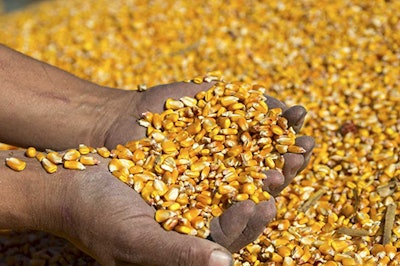
Industrial starch millers can extract higher levels of starch from U.S. corn than corn from other origins, translating into additional profit for plants that rely on U.S. origin, according to a recent study conducted by the U.S. Grains Council (USGC) in cooperation with the University of Illinois’ Agricultural and Biological Engineering Department.
“There are 49 industrial starch plants located outside the United States,” says Kurt Shultz, USGC senior director of global strategies. “Not all of them are in import-dependent locations, however those that do import corn should be choosing U.S. corn over other origins. If they aren’t, they are passing up an opportunity for improving their plant’s overall profitability.”
The study, to be published in the scientific journal Cereal Chemistry later this month, examined U.S.-, Brazilian- and Argentinian-origin corn samples from supplies in starch plant warehouses in Asia, Latin America and the Mediterranean.
Samples were collected and shipped to the University of Illinois under U.S. Department of Agriculture’s Animal and Plant Health Inspection Service (USDA APHIS) permits for comparison of wet milling characteristics and starch yields.
Each was analyzed for its chemical composition, broken corn and foreign material (BCFM), test weight and hardness before being processed into starch, germ, fiber and solubles using optimized laboratory wet-milling procedures.
The experts found that U.S. corn had significantly higher starch yields (68% - 70%) than that of the South American countries (64% - 66%).
“The likely reason for these higher starch extractability levels in U.S. corn is due to the corn hybrids produced here, which affect the ‘mill-ability’ of the grain,” Shultz says. “The starch is more readily available than the harder endosperm hybrids in South America. Typically, buyers focus on the BCFM levels in U.S. corn, but this study shows that even when you account for the BCFM levels in U.S. corn, it still outperforms other origins and actually increases the overall profitability of the plant.”
To put this into perspective, a wet milling plant with a capacity of 2,540 MT (100,000 bushels) of corn/day could expect roughly $6.5 million to $9 million a year in additional revenue if it were to use U.S. corn. According to the Corn Refiners Association (CRA), the industrial corn starch industry worldwide is worth more than $70 billion and consumes approximately 90 MMT (3.5 billion bushels) of corn annually.
“For an increase in every one percent of extracted starch yield from wet milling, the economic return is expected to be around four to six cents per bushel, depending on the sales price of the product and plant capacity,” says Dr. Vijay Singh, distinguished professor of Bioprocessing at the University of Illinois Urbana Champaign, director of the Integrated Bioprocessing Research Laboratory, and the study’s author.

Singh has presented to dozens of international buyers and industry experts through webinars sponsored by USGC about U.S. corn’s higher starch yield and will roll out these results in the coming months to highlight the additional profit opportunity available in U.S. corn.
As a next step, the Illinois Corn Marketing Board has partnered with USGC to expand the scope and impact of this study, allowing USGC to collect two more years of data and broaden the number of international starch plants participating.
“USGC appreciates the financial support and leadership provided by the Illinois Corn Marketing Board,” Shultz says. “It will allow the council to expand the size and scope of this study, which will provide additional data points that will be essential as we engage customers around the world to show them how to capitalize on this performance advantage in U.S. corn.”

















